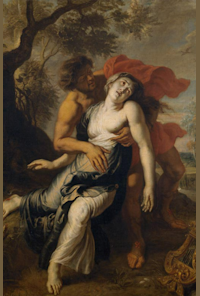New production of the festival (as part of the Monteverdi Trilogy over 3 years directed by Stéphane Fuget, new conductor in residence)
After the great success won last summer with the public and the critics in the Return of Ulysses to his Homeland directed by Stéphane Fuget (see reviews page 28), the latter continues the Monteverdian trilogy with the Orfeo. The Orfeo is the first masterpiece in the history of opera and truly marks its birth. At its first performance in Mantua in 1607, the success was phenomenal. The libretto by Striggio, a model of poetry, recounts the death of Euridice, wife of Orfeo, bitten by a snake. Orfeo goes in search of him to the Underworld. By the virtues of the beauty of his singing, he charms the infernal monsters and manages to obtain from Pluto and Proserpina the release of his beloved. The gods agree to let Euridice go on the condition that Orfeo does not look back before he comes into the light of day. But, yielding to Euridice's entreaties, Orfeo turns around and loses her again. Monteverdi makes striking use of the contrasts of the different colors of the orchestra for dramatic purposes, notably through the use of trombones. He obtains by the simplest means, an extraordinary musical intensity. The arias, of great emotional force, overwhelm us. Thus, Orfeo's lament at the death of Euridice “Tu se' morta, mia vita” or “Rendetemi il mio ben, Tartarei Numi?” his magnificent plea for the release of Euridice. We are very happy to welcome Valerio Contaldo, in the role of Orfeo, but also three admirable young talents (Gwendoline Blondeel, Eva Zaïcik and Marie Perbost) in the main roles of Euridice, the Messenger and Proserpine. Orfeo turns around and loses her again. Monteverdi makes striking use of the contrasts of the different colors of the orchestra for dramatic purposes, notably through the use of trombones. He obtains by the simplest means, an extraordinary musical intensity. The arias, of great emotional force, overwhelm us. Thus, Orfeo's lament at the death of Euridice “Tu se' morta, mia vita” or “Rendetemi il mio ben, Tartarei Numi?” his magnificent plea for the release of Euridice. We are very happy to welcome Valerio Contaldo, in the role of Orfeo, but also three admirable young talents (Gwendoline Blondeel, Eva Zaïcik and Marie Perbost) in the main roles of Euridice, the Messenger and Proserpine. Orfeo turns around and loses her again. Monteverdi makes striking use of the contrasts of the different colors of the orchestra for dramatic purposes, notably through the use of trombones. He obtains by the simplest means, an extraordinary musical intensity. The arias, of great emotional force, overwhelm us. Thus, Orfeo's lament at the death of Euridice “Tu se' morta, mia vita” or “Rendetemi il mio ben, Tartarei Numi?” his magnificent plea for the release of Euridice. We are very happy to welcome Valerio Contaldo, in the role of Orfeo, but also three admirable young talents (Gwendoline Blondeel, Eva Zaïcik and Marie Perbost) in the main roles of Euridice, the Messenger and Proserpine. Monteverdi makes striking use of the contrasts of the different colors of the orchestra for dramatic purposes, notably through the use of trombones. He obtains by the simplest means, an extraordinary musical intensity. The arias, of great emotional force, overwhelm us. Thus, Orfeo's lament at the death of Euridice “Tu se' morta, mia vita” or “Rendetemi il mio ben, Tartarei Numi?” his magnificent plea for the release of Euridice. We are very happy to welcome Valerio Contaldo, in the role of Orfeo, but also three admirable young talents (Gwendoline Blondeel, Eva Zaïcik and Marie Perbost) in the main roles of Euridice, the Messenger and Proserpine. Monteverdi makes striking use of the contrasts of the different colors of the orchestra for dramatic purposes, notably through the use of trombones. He obtains by the simplest means, an extraordinary musical intensity. The arias, of great emotional force, overwhelm us. Thus, Orfeo's lament at the death of Euridice “Tu se' morta, mia vita” or “Rendetemi il mio ben, Tartarei Numi?” his magnificent plea for the release of Euridice. We are very happy to welcome Valerio Contaldo, in the role of Orfeo, but also three admirable young talents (Gwendoline Blondeel, Eva Zaïcik and Marie Perbost) in the main roles of Euridice, the Messenger and Proserpine. extraordinary musical intensity. The arias, of great emotional force, overwhelm us. Thus, Orfeo's lament at the death of Euridice “Tu se' morta, mia vita” or “Rendetemi il mio ben, Tartarei Numi?” his magnificent plea for the release of Euridice. We are very happy to welcome Valerio Contaldo, in the role of Orfeo, but also three admirable young talents (Gwendoline Blondeel, Eva Zaïcik and Marie Perbost) in the main roles of Euridice, the Messenger and Proserpine. extraordinary musical intensity. The arias, of great emotional force, overwhelm us. Thus, Orfeo's lament at the death of Euridice “Tu se' morta, mia vita” or “Rendetemi il mio ben, Tartarei Numi?” his magnificent plea for the release of Euridice. We are very happy to welcome Valerio Contaldo, in the role of Orfeo, but also three admirable young talents (Gwendoline Blondeel, Eva Zaïcik and Marie Perbost) in the main roles of Euridice, the Messenger and Proserpine.




